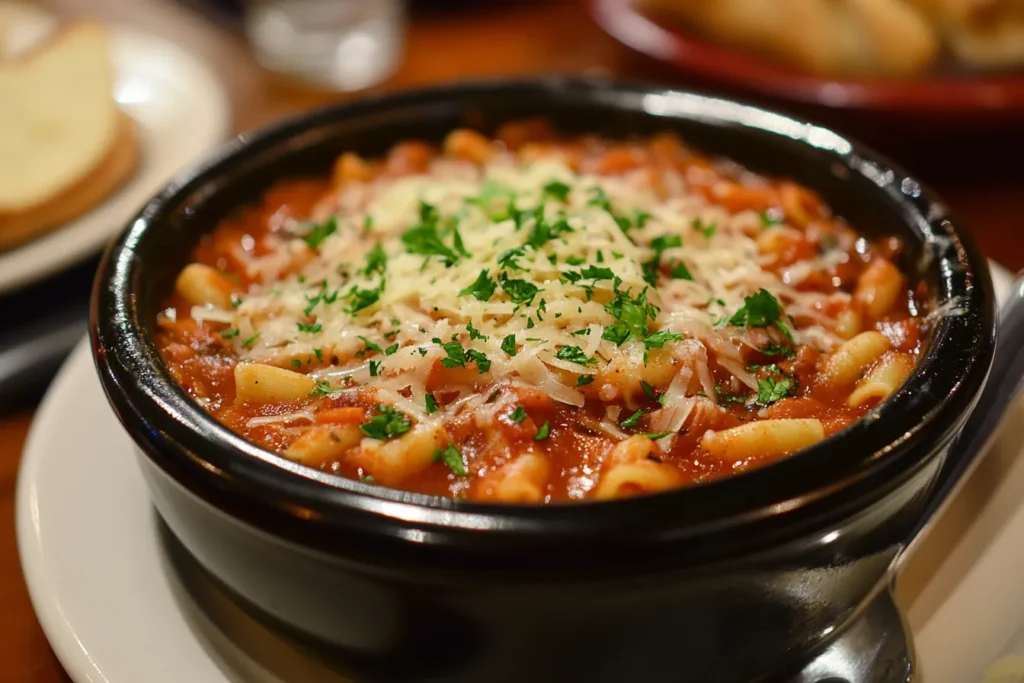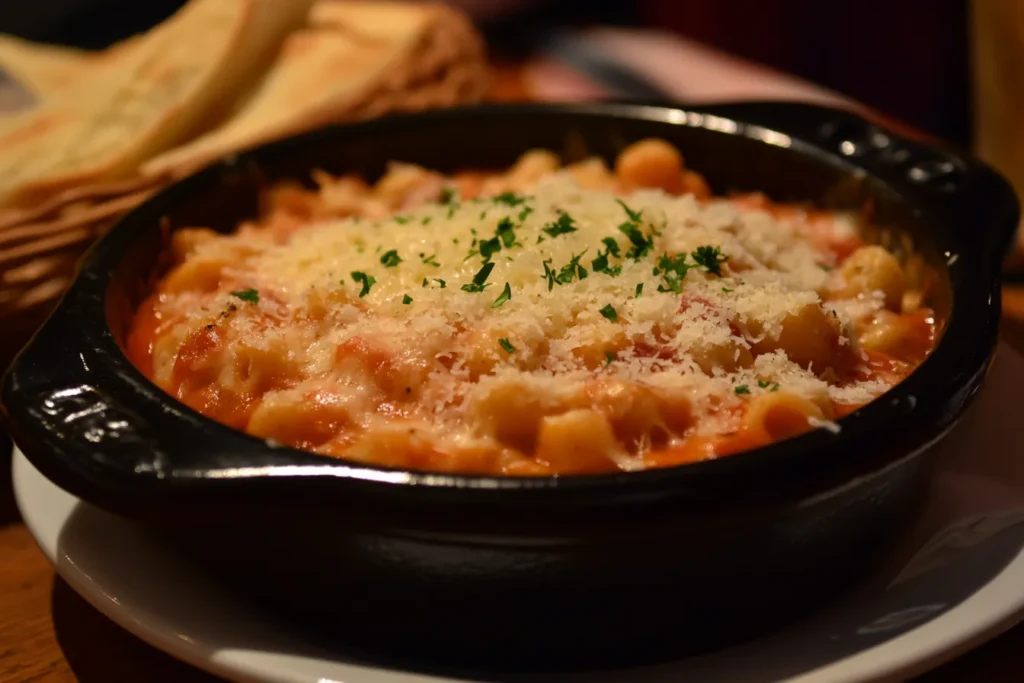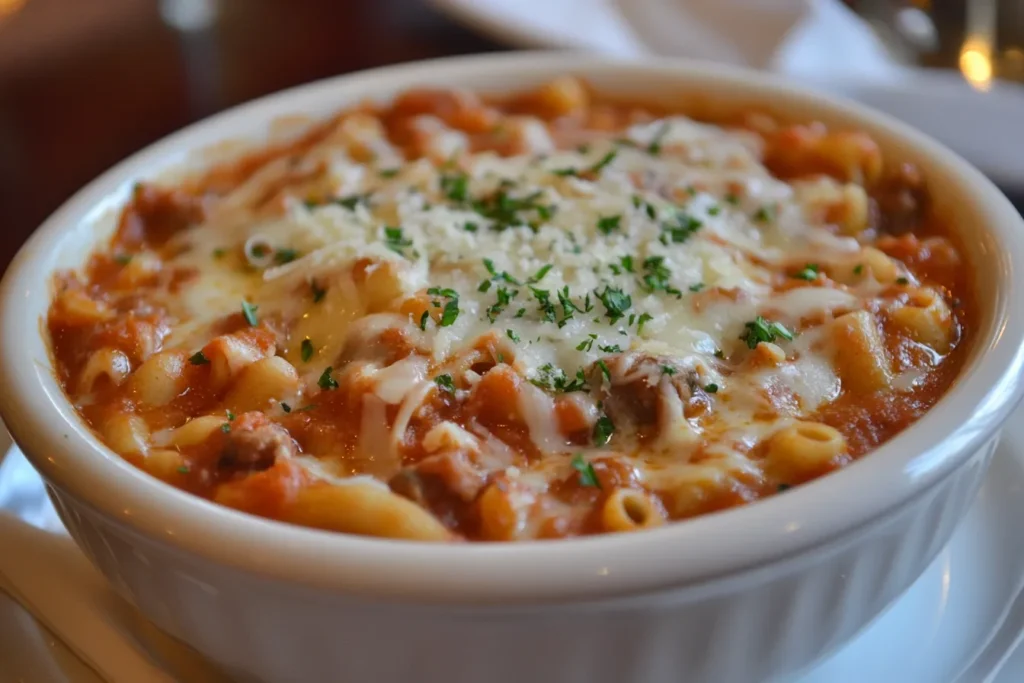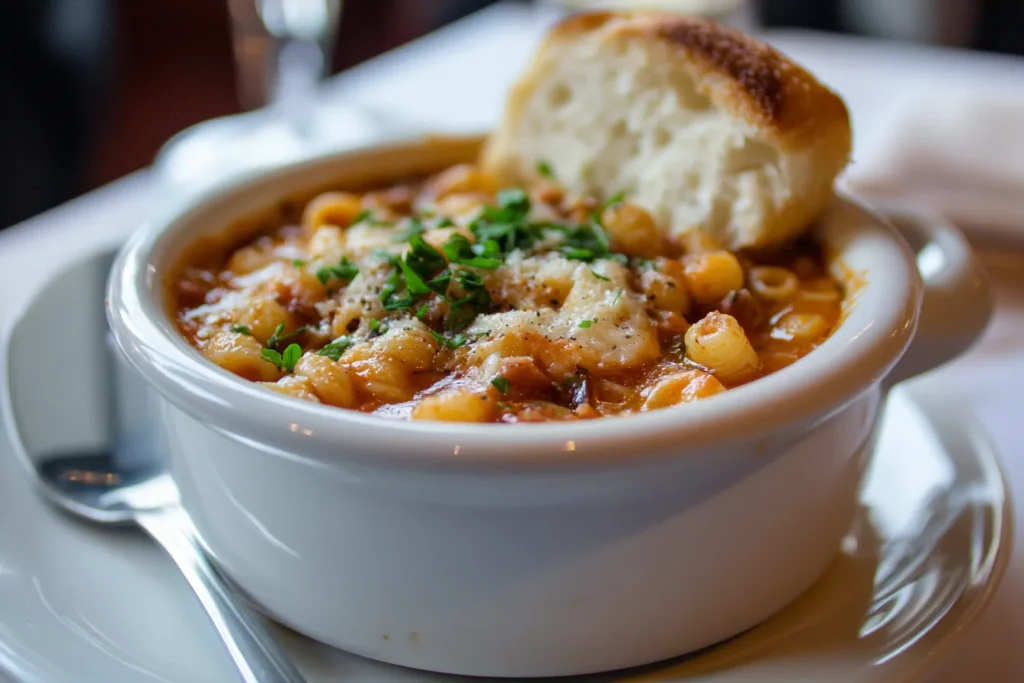Have you ever sat down to enjoy Olive Garden’s Pasta e Fagioli and wondered, “Wait, does this have meat in it?” You’re not alone! Whether you’re vegetarian, cutting back on meat, or just curious about what’s in your food, knowing the ingredients can make all the difference. The good news? We’re here to clear up any confusion so you can enjoy your meal worry-free. I’ve been there too—scanning menus or asking the waiter for details, only to still feel unsure. Let’s break it down together so you can decide if this hearty Italian soup fits your dietary preferences.
List Of Contents
1. Overview of Pasta Fagioli at Olive Garden
Pasta Fagioli is one of Olive Garden’s standout menu items, adored by fans for its rich flavors and comforting texture. Often referred to as pasta and bean soup, this dish is hearty, nutritious, and perfectly embodies the essence of Italian comfort food. What sets Olive Garden’s Pasta Fagioli apart is its ability to blend traditional Italian roots with the chain’s unique culinary flair. This soup has become a staple for customers seeking something wholesome yet satisfying.
At its core, Pasta Fagioli is a symphony of simple ingredients, including pasta, beans, and vegetables, simmered in a flavorful broth. The Olive Garden version, however, adds its signature twist with the inclusion of savory ground beef, vibrant spices, and a perfect balance of textures. Check out more recipes here.

2. The Traditional Roots of Pasta Fagioli
Originating from humble beginnings in Italy, Pasta Fagioli translates to “pasta and beans.” This dish was a staple in Italian households, cherished for its affordability and nutritional value. Traditionally, it was a vegetarian or even vegan recipe, reflecting its creation as a meal for the working class.
Italian grandmothers often crafted Pasta Fagioli from scratch, relying on local ingredients like fresh beans, homemade pasta, and aromatic herbs. Each region of Italy brought its own spin, with variations in broth thickness, pasta shapes, and spices.
Olive Garden’s adaptation retains the heart of this dish while catering to modern palates. It bridges the gap between tradition and innovation, offering a recipe that celebrates its Italian roots while embracing a contemporary dining experience. Check out more recipes here.
3. Key Ingredients in Classic Pasta Fagioli
At the foundation of any Pasta Fagioli recipe are a few essential ingredients:
- Beans: Usually cannellini or borlotti beans, providing protein and creaminess.
- Pasta: Small shapes like ditalini or elbow pasta are most common.
- Vegetables: Onions, carrots, and celery form a classic sofrito base.
- Tomatoes: whether fresh or canned, contribute both acidity and sweetness to the dish.
- Herbs and Spices: Basil, oregano, rosemary, and bay leaves infuse the dish with warmth.
- Broth: A savory base, often vegetable stock or meat-based broth, ties the ingredients together.
Olive Garden takes these essentials and enhances them with a richer broth and the inclusion of ground beef, resulting in a hearty, protein-packed meal. Check out more recipes here.
4. Olive Garden’s Unique Recipe for Pasta Fagioli
Olive Garden enhances classic Pasta Fagioli with its unique signature twist. Their recipe includes:
- Ground Beef: Adds depth and hearty flavor.
- Italian Seasoning Blend: A proprietary mix of spices gives the dish a unique kick.
- Tomato and Beef Broth Base: A robust broth that combines tangy tomatoes with savory beef undertones.
- Beans: Red kidney beans and cannellini beans are used for varied texture.
- Ditalini Pasta: Small, chewy pasta that perfectly absorbs the flavorful broth.
This modernized take on a classic dish reflects Olive Garden’s commitment to satisfying a diverse customer base while honoring Italian culinary heritage. Check out more recipes here.
5. What Makes Olive Garden’s Version Special?
What sets Olive Garden’s Pasta Fagioli apart is its balanced complexity. While it stays true to the dish’s rustic roots, it offers a more indulgent experience. Key features include:
- Meaty Goodness: Departing from traditional vegetarian recipes, Olive Garden includes ground beef to add richness.
- Consistency: This soup strikes an ideal balance between a broth and a stew, offering a hearty yet light dish.
- Accessibility: Olive Garden ensures the dish appeals to a broad audience by keeping the flavors mild yet flavorful.
Additionally, the dish pairs seamlessly with Olive Garden’s famous breadsticks and salads, making it a customer favorite.
6. The Significance of Meat in Pasta Fagioli Recipes
Pasta Fagioli was traditionally prepared without meat, though many variations have developed over time. Meat, such as sausage or beef, enhances the flavor and makes the dish heartier. Olive Garden’s choice of ground beef complements the beans and pasta, delivering a savory depth that appeals to meat lovers.
The inclusion of meat also boosts the nutritional profile, providing protein and iron. However, vegetarians can easily adapt the recipe by swapping meat with plant-based alternatives or simply omitting it.
7. Olive Garden’s Pasta Fagioli: A Quick Glance at the Ingredients
For a quick breakdown, Olive Garden’s recipe includes:
- Ground beef for savoriness.
- Ditalini pasta for texture.
- Red kidney beans and cannellini beans for protein and creaminess.
- A tomato-based broth enriched with Italian herbs.
- Carrots, celery, and onions are used to enhance the flavor.
This ingredient list highlights the dish’s balanced composition, ensuring every bite is a medley of textures and tastes.
8. Variations of Pasta Fagioli in Italian Cuisine

Pasta Fagioli recipes differ across Italy, reflecting regional tastes and traditions:
- Northern Italy: Creamier versions using borlotti beans.
- Southern Italy: Spicier recipes with red pepper flakes.
- Coastal Areas: Seafood-based broths replacing meat.
Olive Garden’s version is a harmonious blend of multiple styles, making it universally appealing.
9. Understanding the Flavor Profile of Olive Garden’s Pasta Fagioli
The dish combines:
- Savory Notes: From the beef and broth.
- Earthy Undertones: Thanks to the beans and vegetables.
- Herbal Aromas: Courtesy of the Italian seasoning blend.
- Tangy Sweetness: From tomatoes.
This creates a comforting yet complex taste, ensuring it stands out on the menu.
10. The Appeal of Pasta Fagioli on Olive Garden’s Menu
Pasta Fagioli’s popularity lies in its versatility. Whether you’re craving something light or substantial, this dish delivers. It’s also an affordable option, often included in Olive Garden’s soup and salad combo, making it a go-to choice for customers.
The dish’s appeal spans across age groups and dietary preferences, ensuring its place as a beloved staple on Olive Garden’s menu.
11. Key Protein Sources in Olive Garden’s Pasta Fagioli
Protein is an integral component of Olive Garden’s Pasta Fagioli, largely contributed by two main sources: ground beef and beans. These ingredients work together to create a hearty, satisfying dish. While beans like cannellini and kidney beans provide plant-based protein, the inclusion of meat significantly boosts the protein content, making it appealing to those seeking a more filling meal.
The ground beef adds a savory, umami-rich layer that complements the natural creaminess of the beans, giving the dish its unique texture and flavor. It’s this combination that sets Olive Garden’s version apart from traditional vegetarian renditions.
12. Meat Components in the Dish: Beef and Sausage
Although ground beef is the primary meat in Olive Garden’s Pasta Fagioli, some recipes and variations might also include Italian sausage for an added layer of spice and flavor complexity. The use of beef makes the dish hearty without overpowering the delicate flavors of the beans and pasta.
By incorporating beef into the tomato-based broth, Olive Garden ensures the dish strikes a balance between protein-rich and comforting. This choice also appeals to a wider audience who may prefer a meat-forward take on a classic Italian soup.
13. Vegetarian and Vegan Considerations
For vegetarians or vegans dining at Olive Garden, the presence of meat in Pasta Fagioli poses a challenge. However, there are ways to adapt or substitute the recipe:
- Vegetarian Options: Ask your server if the meat can be omitted or substituted. Alternatively, consider other vegetarian-friendly soups on the menu, like the famous Zuppa Toscana, which can sometimes be customized.
- Vegan Adjustments: A meat-free Pasta Fagioli can be made by using vegetable broth and omitting any cheese garnishes.
Despite these adaptations, Olive Garden’s standard version of Pasta Fagioli is not vegetarian or vegan due to the ground beef used.
14. Comparing Olive Garden’s Recipe to Meat-Free Options
Olive Garden’s version of Pasta Fagioli is a richer and more indulgent take compared to its traditional vegetarian counterparts. Meat-free versions rely on the depth of flavor from ingredients like garlic, onions, and herbs, while Olive Garden’s inclusion of beef adds a robust umami quality.
Additionally, traditional meat-free recipes are often lighter, focusing on the freshness of vegetables and beans. Olive Garden’s rendition, by contrast, is designed to be hearty and filling, catering to those seeking a substantial meal.
15. Exploring Substitutes for Meat in Pasta Fagioli
For those looking to replicate Olive Garden’s Pasta Fagioli without meat, there are several excellent substitutes:
- Plant-Based Ground “Meat”: These products mimic the texture and flavor of beef while being entirely vegetarian.
- Mushrooms: Diced or ground mushrooms provide a savory umami flavor that complements the dish.
- Lentils: A high-protein, plant-based option that mimics the heartiness of ground beef.
- Tofu Crumbles: Seasoned tofu can replicate the texture and flavor profile of meat.
These alternatives allow for a vegetarian or vegan version of the dish without sacrificing its satisfying texture and flavor.
16. How Meat Affects the Dish’s Texture and Flavor
Meat plays a pivotal role in shaping the overall texture and flavor profile of Olive Garden’s Pasta Fagioli. Ground beef contributes a tender chewiness, balancing the softer textures of beans and pasta. Additionally, the beef enriches the broth with savory notes, enhancing its depth and complexity.
Without meat, the dish leans heavily on herbs and vegetables for flavor, resulting in a lighter and less robust version. Meat’s ability to release fats and juices during cooking creates a luscious, well-rounded base that ties all ingredients together.
17. How Meat is Cooked and Incorporated in the Dish
In Olive Garden’s kitchen, the ground beef for Pasta Fagioli is likely browned separately to develop its flavor before being incorporated into the soup. This process ensures the meat is evenly cooked and prevents the broth from becoming greasy.
Once browned, the beef is simmered alongside the other ingredients, allowing the flavors to meld together. This slow cooking process ensures the meat is tender and the broth is infused with its rich, savory essence.
18. Can You Request a Meat-Free Version at Olive Garden?
While the standard recipe includes ground beef, Olive Garden is known for accommodating customer preferences. Here are some tips:
- Ask for Customization: Request a meat-free version of the soup. Although not guaranteed, many locations are willing to make adjustments.
- Consider Other Options: Explore Olive Garden’s vegetarian dishes or ask about seasonal soup offerings that might meet dietary preferences.
- Plan Ahead: Call the restaurant in advance to inquire about customization options.
This flexibility makes Olive Garden a welcoming spot for those with specific dietary needs.
19. Nutritional Breakdown of the Dish with Meat

Including meat in Pasta Fagioli significantly affects its nutritional profile. Here’s a quick snapshot:
- Protein: The addition of ground beef boosts the protein content, making the dish more satiating.
- Calories: The beef adds calories, but these are balanced by the soup’s high fiber content from beans and vegetables.
- Fat Content: Ground beef contributes healthy fats, though leaner cuts are often used to keep the dish balanced.
- Carbs: Pasta and beans provide a steady source of carbohydrates for energy.
Overall, the meat version is a well-rounded meal suitable for those seeking a nutrient-dense, filling option.
20. Allergens and Meat-Related Concerns for Customers
For customers with dietary restrictions, it’s important to consider the following:
- Beef Allergies: While rare, some may need to avoid the dish entirely if allergic to beef.
- Cross-Contamination: In shared kitchens, vegetarian versions may come into contact with meat products.
- Kosher or Halal Requirements: The inclusion of beef means the dish may not meet specific dietary laws unless modifications are made.
Olive Garden’s staff can help clarify allergen concerns, ensuring every customer has a safe and enjoyable dining experience.
21. Customizing Olive Garden’s Pasta Fagioli to Your Dietary Needs
One of the highlights of Pasta Fagioli is its versatility. At Olive Garden, diners can often modify the dish to align with their dietary preferences. Whether you’re vegan, vegetarian, gluten-free, or looking to lower sodium levels, small adjustments can make a big difference.
Customizations to Consider:
- Vegetarian: Request the soup without meat, or substitute with plant-based options like lentils or mushrooms if available.
- Vegan: Along with omitting meat, ensure the broth used is vegetable-based and skip cheese garnishes.
- Gluten-Free: Swap the traditional ditalini pasta for gluten-free pasta or enjoy the soup without pasta entirely.
- Low-Sodium: Ask for reduced-sodium broth or prepare it at home to better control the salt content.
Olive Garden’s chefs are often open to substitutions, making it easier for customers to enjoy a personalized dining experience.
22. Sides That Pair Well with Pasta Fagioli
The hearty and rich Pasta Fagioli pairs beautifully with a variety of sides, enhancing its flavors and making for a well-rounded meal. Some customer-favorite sides include:
- Garlic Breadsticks: The warm, soft breadsticks are ideal for soaking up the flavorful broth.
- House Salad: A crisp salad with Italian dressing offers a refreshing contrast to the soup’s heartiness.
- Bruschetta: Toasted bread topped with tomatoes and basil adds a light and zesty complement.
- Parmesan-Crusted Potatoes: This indulgent side pairs well with the soup’s rustic charm.
These additions create a dining experience that feels both traditional and indulgent.
23. Making Olive Garden-Style Pasta Fagioli at Home
Recreating Olive Garden’s Pasta Fagioli in your kitchen is simpler than you might think. With the right ingredients and some patience, you can achieve a dish that rivals the restaurant version.
Key Ingredients for Success:
- Ground Beef: Opt for lean beef for a healthier option.
- Beans: Use a mix of red kidney beans and cannellini beans for a creamy texture.
- Ditalini Pasta: The small size works perfectly in soups.
- Tomato-Based Broth: Combine canned tomatoes, beef stock, and Italian herbs for the signature flavor.
Steps:
- Brown the beef with onions, carrots, and celery.
- Add tomatoes, beans, and seasonings.
- Simmer until the flavors meld together.
- Cook pasta separately and stir it into the soup before serving.
This homemade version offers the flexibility to tweak flavors and ingredients to your liking.
24. How to Achieve the Perfect Balance of Ingredients
The secret to a great Pasta Fagioli lies in achieving the perfect balance between its components. Here’s how Olive Garden perfects this art:
- Ratio of Pasta to Broth: The pasta should absorb the broth without becoming soggy. Cook it al dente for the best results.
- Meat and Beans: Combine these in equal parts to create a harmonious texture.
- Herbs and Seasonings: Use fresh or dried Italian herbs to enhance the broth without overwhelming the dish.
- Acidity and Sweetness: Balance the tanginess of tomatoes with a hint of sugar or a splash of balsamic vinegar.
This attention to detail ensures every bite is as satisfying as the last.
25. Exploring Meatless Versions of Pasta Fagioli
For those who prefer a meat-free version, Pasta Fagioli adapts beautifully without compromising on taste. By using plant-based protein sources like lentils, tofu crumbles, or chickpeas, you can replicate the heartiness of the dish.

Vegetarian-Friendly Tips:
- Use vegetable stock instead of beef broth.
- Incorporate smoky spices like paprika to mimic the depth of flavor meat provides.
- Add extra vegetables, such as zucchini or kale, to bulk up the soup.
These adaptations keep the dish nutritious, flavorful, and aligned with dietary preferences.
26. Frequently Asked Questions About Olive Garden’s Pasta Fagioli
1. Does Olive Garden’s Pasta Fagioli contain dairy?
The soup itself does not contain dairy, but cheese is often added as a garnish. This can be omitted upon request.
2. Is Pasta Fagioli gluten-free?
No, the standard recipe includes pasta made with wheat. However, you can request gluten-free pasta or remove the pasta entirely.
3. Does it contain pork?
Typically, the dish uses beef, but some recipes might include pork-based sausage. It’s best to confirm with the restaurant.
4. Can I freeze leftovers?
Yes! Pasta Fagioli freezes well. Store it in an airtight container and reheat on the stovetop or in the microwave.
5. How long does it stay fresh?
The soup can be refrigerated for up to 3-4 days. For best results, store the pasta separately to prevent it from becoming mushy.
6. What’s the calorie count?
One serving typically contains 150-200 calories, but this varies depending on portion size and ingredients.
7. Is it spicy?
Olive Garden’s version is mild, but you can add red pepper flakes for heat.
8. Can I substitute beans?
Yes, use any beans you prefer, such as black beans or garbanzo beans, for a unique twist.
9. What’s the portion size?
A serving is roughly one cup, but portion sizes can vary depending on your appetite.
10. Does Olive Garden serve this dish year-round?
Yes, Pasta Fagioli is a staple on the menu and available year-round.
27. Olive Garden’s Approach to Recipe Transparency
Olive Garden prioritizes customer satisfaction by offering transparency in their recipes and ingredients. Their online menu and nutritional guides detail major components, making it easier for diners to make informed choices.
For those with specific dietary needs, the staff is trained to address concerns, ensuring a comfortable dining experience. This approach solidifies Olive Garden’s reputation as a customer-centric restaurant.
28. Customer Reviews on Meat Presence in Pasta Fagioli
Many customers rave about the inclusion of meat in Olive Garden’s Pasta Fagioli, praising its ability to add flavor and substance to the dish. Common sentiments include:
- “Perfectly hearty and filling!”
- “The ground beef makes this soup feel like a full meal.”
- “I love the meat, but I wish there were a vegetarian option.”
While the meat is widely appreciated, some diners express interest in meat-free variations, reflecting the growing demand for plant-based options.
29. Comparing Pasta Fagioli Across Chain Restaurants
Olive Garden isn’t the only chain offering Pasta Fagioli. Competitors like Carrabba’s Italian Grill and Maggiano’s Little Italy also feature their takes on this classic soup. However, Olive Garden’s version stands out for its:
- Consistency: Available year-round and prepared to exacting standards.
- Accessibility: Offered at an affordable price and often as part of a soup-and-salad combo.
- Customization: More options for tailoring the dish to individual preferences.
This consistency keeps Olive Garden ahead in the competitive Italian restaurant market.
30. Final Thoughts: Enjoying Pasta Fagioli for Everyone
Whether you’re dining in or making it at home, Olive Garden’s Pasta Fagioli offers something for everyone. Its hearty combination of pasta, beans, and meat delivers comfort and satisfaction, while its versatility makes it adaptable to a wide range of dietary preferences.
By celebrating tradition while embracing innovation, Olive Garden ensures that Pasta Fagioli remains a beloved staple on its menu.
